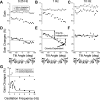Tuning of gravity-dependent and gravity-independent vertical angular VOR gain changes by frequency of adaptation
- PMID: 22402654
- PMCID: PMC3378407
- DOI: 10.1152/jn.01075.2011
Tuning of gravity-dependent and gravity-independent vertical angular VOR gain changes by frequency of adaptation
Abstract
The gain of the vertical angular vestibulo-ocular reflex (aVOR) was adaptively increased and decreased in a side-down head orientation for 4 h in two cynomolgus monkeys. Adaptation was performed at 0.25, 1, 2, or 4 Hz. The gravity-dependent and -independent gain changes were determined over a range of head orientations from left-side-down to right-side-down at frequencies from 0.25 to 10 Hz, before and after adaptation. Gain changes vs. frequency data were fit with a Gaussian to determine the frequency at which the peak gain change occurred, as well as the tuning width. The frequency at which the peak gravity-dependent gain change occurred was approximately equal to the frequency of adaptation, and the width increased monotonically with increases in the frequency of adaptation. The gravity-independent component was tuned to the adaptive frequency of 0.25 Hz but was uniformly distributed over all frequencies when the adaptation frequency was 1-4 Hz. The amplitude of the gravity-independent gain changes was larger after the aVOR gain decrease than after the gain increase across all tested frequencies. For the aVOR gain decrease, the phase lagged about 4° for frequencies below the adaptation frequency and led for frequencies above the adaptation frequency. For gain increases, the phase relationship as a function of frequency was inverted. This study demonstrates that the previously described dependence of aVOR gain adaptation on frequency is a property of the gravity-dependent component of the aVOR only. The gravity-independent component of the aVOR had a substantial tuning curve only at an adaptation frequency of 0.25 Hz.
Figures




Similar articles
-
Gravity-dependent and gravity-independent gain changes during vertical vestibulo-ocular reflex (VOR) adaptation.J Gravit Physiol. 2004 Jul;11(2):P9-12. J Gravit Physiol. 2004. PMID: 16231429
-
Gravity-specific adaptation of the angular vestibuloocular reflex: dependence on head orientation with regard to gravity.J Neurophysiol. 2003 Jan;89(1):571-86. doi: 10.1152/jn.00287.2002. J Neurophysiol. 2003. PMID: 12522203
-
Spatial distribution of gravity-dependent gain changes in the vestibuloocular reflex.J Neurophysiol. 2005 Jun;93(6):3693-8. doi: 10.1152/jn.01269.2004. Epub 2005 Feb 2. J Neurophysiol. 2005. PMID: 15689386
-
The role of gravity in adaptation of the vertical angular vestibulo-ocular reflex.Ann N Y Acad Sci. 2005 Apr;1039:97-110. doi: 10.1196/annals.1325.010. Ann N Y Acad Sci. 2005. PMID: 15826965
-
Dependence of the roll angular vestibuloocular reflex (aVOR) on gravity.J Neurophysiol. 2009 Nov;102(5):2616-26. doi: 10.1152/jn.00245.2009. Epub 2009 Aug 19. J Neurophysiol. 2009. PMID: 19692515 Free PMC article.
Cited by
-
Modeling spatial tuning of adaptation of the angular vestibulo-ocular reflex.Exp Brain Res. 2012 Jul;220(2):165-78. doi: 10.1007/s00221-012-3127-3. Epub 2012 Jun 4. Exp Brain Res. 2012. PMID: 22660376 Free PMC article.
References
-
- Armand M, Minor LB. Relationship between time- and frequency-domain analyses of angular head movements in the squirrel monkey. J Comput Neurosci 11: 217–239, 2001 - PubMed
-
- Baker J, Wickland C, Peterson B. Dependence of cat vestibulo-ocular reflex direction adaptation on animal orientation during adaptation and rotation in darkness. Brain Res 408: 339–343, 1987 - PubMed
-
- Baker JF, Harrison REW, Isu N, Wickland C, Peterson B. Dynamics of adaptive change in the vestibulo-ocular reflex direction. II. Sagittal plane rotations. Brain Res 371: 166–170, 1986 - PubMed
-
- Blazquez PM, Hirata Y, Highstein SM. Chronic changes in inputs to dorsal Y neurons accompany VOR motor learning. J Neurophysiol 95: 1812–1825, 2006 - PubMed
-
- Boyden ES, Katoh A, Pyle JL, Chatila TA, Tsien RW, Raymond JL. Selective engagement of plasticity mechanisms for motor memory storage. Neuron 51: 823–834, 2006 - PubMed
Publication types
MeSH terms
Grants and funding
LinkOut - more resources
Full Text Sources

